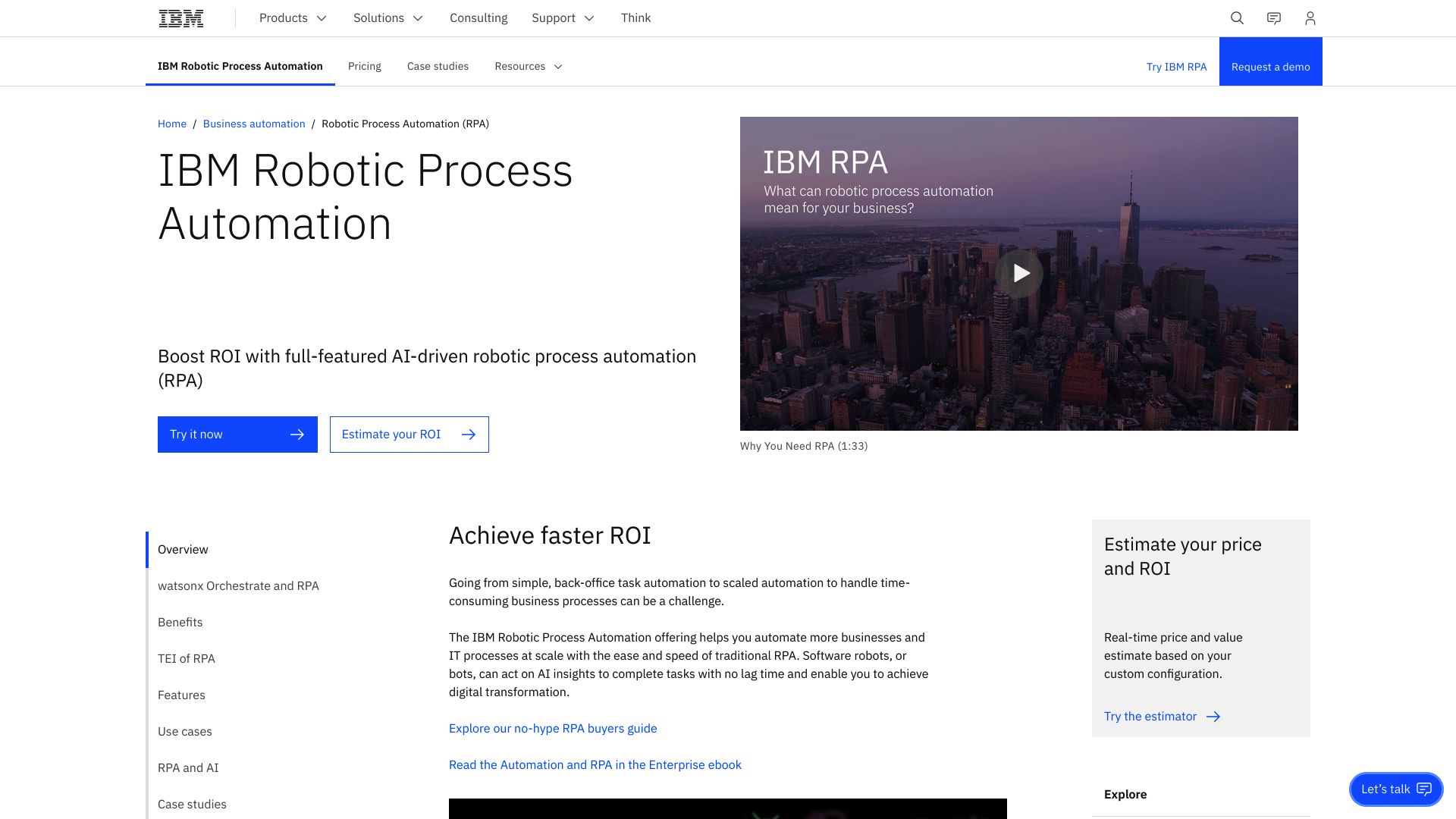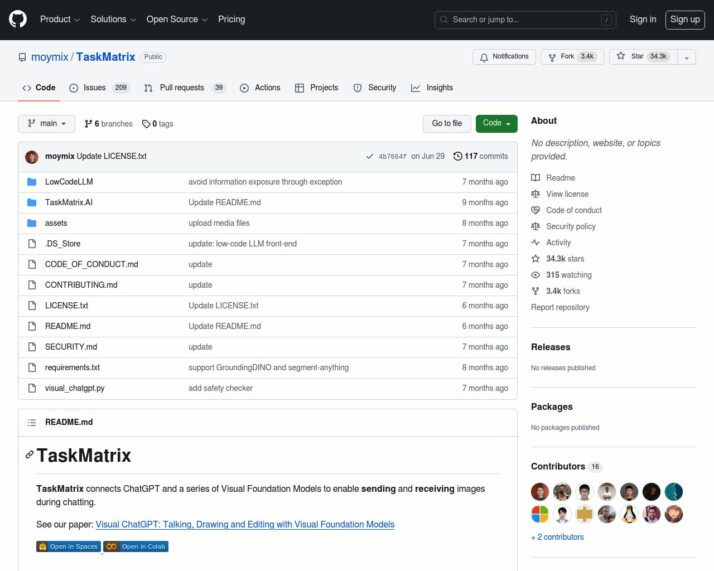IBM RPA vs. TaskMatrix: AI Automation Titans Compared
AI-powered automation transforms business operations, but choosing the right platform can be challenging. This comparison of IBM RPA vs. TaskMatrix, and SmythOS illuminates key differences in functionality, ease of use, and scalability. IBM RPA offers robust enterprise automation, while TaskMatrix connects foundation models with specialized APIs.
SmythOS, however, emerges as a versatile solution, combining powerful AI capabilities with user-friendly design. Whether you’re a developer seeking advanced integrations, a business leader focused on scalability, or a non-technical user looking for accessible AI tools, this guide provides essential insights to inform your decision. Discover how each platform addresses automation needs, supports AI innovation, and potentially revolutionizes your workflow.
IBM RPA Overview
IBM RPA streamlines business operations through intelligent automation. The platform empowers organizations to create software robots that handle repetitive tasks across enterprise applications, freeing human workers to focus on higher-value activities.


IBM RPA’s visual builder enables rapid bot development with drag-and-drop functionality and pre-built commands. This low-code approach allows both technical and non-technical users to automate workflows efficiently. The platform supports unattended bots for fully autonomous processes and attended bots for human-AI collaboration, providing flexibility for various automation scenarios.
IBM RPA’s visual builder enables rapid bot development with drag-and-drop functionality and pre-built commands. This low-code approach allows both technical and non-technical users to automate workflows efficiently.
Integration capabilities set IBM RPA apart. The software connects seamlessly with mainframes, APIs, and desktop applications, allowing bots to interact across diverse IT environments. This versatility, combined with AI-powered decision-making through watsonx Orchestrate integration, enables complex process automation beyond simple rule-based tasks.
Scalability and governance are key strengths of IBM RPA. The platform supports concurrent bot execution for enterprise-wide deployment. Integration with IBM OpenPages ensures compliance, transparency, and auditability of automated processes. While powerful, IBM RPA’s enterprise focus may present a steeper learning curve for small businesses or individual users compared to some alternatives.
IBM RPA positions itself as a comprehensive automation solution for large organizations. Its robust feature set, enterprise-grade security, and scalability make it well-suited for businesses looking to implement RPA at scale. However, companies seeking a more lightweight or specialized automation tool may find other options better aligned with their needs.
TaskMatrix Overview
TaskMatrix.AI, developed by Microsoft, enhances the capabilities of foundation models like GPT-4 by integrating them with specialized models through APIs. This AI-powered ecosystem functions as a project manager, connecting diverse AI models to perform a wide range of tasks efficiently.


Microsoft’s Intelligent Computing division created TaskMatrix.AI to push the boundaries of artificial intelligence. The system bridges the gap between general-purpose foundation models and specialized APIs, enabling the execution of both digital and physical tasks. TaskMatrix.AI understands user instructions, generates executable action codes, and performs tasks using appropriate APIs.
TaskMatrix.AI enhances the capabilities of foundation models like GPT-4 by integrating them with specialized models through APIs. This AI-powered ecosystem functions as a project manager, connecting diverse AI models to perform a wide range of tasks efficiently.
Key components of TaskMatrix.AI include a conversational foundation model for understanding multimodal inputs, a comprehensive API platform, an API selector for choosing the most suitable APIs, and an action executor. The platform’s uniqueness lies in its ability to perform both digital and physical tasks, lifelong learning capabilities, and provision of interpretable responses.
TaskMatrix.AI offers custom AI model creation, pretrained models, API connectors, and an extensive resource library for developers. Its modular design and continuous learning capability make it a versatile tool for integrating advanced AI into various operations. The platform’s vision is to create an AI ecosystem that leverages both foundation models and specialized APIs to accomplish complex tasks, enhancing productivity and creativity across domains such as office automation, robotics, and the Internet of Things.
TaskMatrix.AI offers custom AI model creation, pretrained models, API connectors, and an extensive resource library for developers. Its modular design and continuous learning capability make it a versatile tool…
While TaskMatrix.AI provides powerful capabilities, it may present challenges in terms of integration complexity and potential learning curve for non-technical users. The open-source nature of the platform allows for flexibility but might require more technical expertise compared to some commercial alternatives. As with any AI system, users should also consider data privacy and ethical implications when implementing TaskMatrix.AI in their projects.
Feature Comparison
IBM RPA and TaskMatrix offer distinct approaches to automation and AI integration. IBM RPA excels in enterprise-grade robotic process automation, providing a comprehensive platform for automating repetitive business tasks. It features a visual bot builder, supports both attended and unattended automation, and integrates seamlessly with existing enterprise systems. IBM RPA’s strength lies in its scalability, security features, and governance tools, making it well-suited for large organizations with complex automation needs.
TaskMatrix, developed by Microsoft, takes a different approach by enhancing foundation models like GPT-4 through API integration with specialized models. It functions more as an AI ecosystem and project manager, capable of understanding multimodal inputs and executing both digital and physical tasks. TaskMatrix’s unique selling point is its ability to connect powerful foundation models with millions of APIs, enabling a vast range of task executions across different domains.
While both platforms offer visual builders and support for AI integration, they differ significantly in their core components and security features. IBM RPA provides robust enterprise security measures, including data encryption and integration with governance tools like IBM OpenPages. TaskMatrix, being more focused on AI model integration, may not offer the same level of enterprise-grade security features out of the box. However, TaskMatrix’s open-source nature and modular design provide flexibility for customization that may appeal to developers and researchers looking to push the boundaries of AI capabilities.
Feature Comparison Table
| IBM RPA | TaskMatrix | SmythOS | |
|---|---|---|---|
| CORE FEATURES | |||
| AI Agents | ❌ | ✅ | ✅ |
| Memory & Context | ❌ | ✅ | ✅ |
| Autonomous Agents | ❌ | ✅ | ✅ |
| Explainability & Transparency | ❌ | ✅ | ✅ |
| Multimodal | ❌ | ✅ | ✅ |
| Problem-Solving Capabilities | ❌ | ✅ | ✅ |
| Multi-Agent Collaboration | ❌ | ✅ | ✅ |
| Work as Team | ❌ | ✅ | ✅ |
| SECURITY | |||
| Constrained Alignment | ❌ | ✅ | ✅ |
| OAuth | ❌ | ✅ | ✅ |
| IP Control | ❌ | ✅ | ✅ |
| COMPONENTS | |||
| Foundation AIs | ❌ | ✅ | ✅ |
| Huggingface AIs | ❌ | ✅ | ✅ |
| Zapier APIs | ❌ | ✅ | ✅ |
| Classifiers | ❌ | ✅ | ✅ |
| Data Lakes | ❌ | ❌ | ✅ |
| DEPLOYMENT OPTIONS (EMBODIMENTS) | |||
| Deploy as Webhook | ❌ | ✅ | ✅ |
| Staging Domains | ❌ | ✅ | ✅ |
| Production Domains | ❌ | ✅ | ✅ |
| API Authentication (OAuth + Key) | ❌ | ✅ | ✅ |
| Deploy as Site Chat | ❌ | ✅ | ✅ |
| Deploy as GPT | ❌ | ✅ | ✅ |
| DATA LAKE SUPPORT | |||
| Hosted Vector Database | ❌ | ❌ | ✅ |
| Sitemap Crawler | ❌ | ❌ | ✅ |
| YouTube Transcript Crawler | ❌ | ❌ | ✅ |
| URL Crawler | ❌ | ✅ | ✅ |
Best Alternative to IBM RPA and TaskMatrix
SmythOS stands out as the superior alternative to IBM RPA and TaskMatrix, offering a comprehensive AI agent development platform that combines ease of use with powerful features. Our drag-and-drop interface simplifies the creation of complex AI workflows, making advanced AI functionalities accessible to users of all skill levels.
Unlike IBM RPA’s focus on robotic process automation and TaskMatrix’s emphasis on AI model integration, SmythOS provides a versatile ecosystem for building and deploying AI agents across various use cases. We offer seamless integration with multiple AI models, APIs, and data sources, enabling users to create sophisticated agents that can handle a wide range of tasks autonomously.
SmythOS excels in areas where IBM RPA and TaskMatrix fall short. While IBM RPA lacks AI agent capabilities and TaskMatrix focuses primarily on AI model connections, SmythOS provides a complete solution for creating, managing, and deploying intelligent agents. Our platform supports multimodal interactions, problem-solving capabilities, and multi-agent collaboration, features that are limited or absent in the alternatives.
SmythOS provides a complete solution for creating, managing, and deploying intelligent agents… supports multimodal interactions, problem-solving capabilities, and multi-agent collaboration
Security and scalability are paramount in SmythOS. We offer robust data encryption, OAuth integration, and IP control features that match or exceed those of IBM RPA and TaskMatrix. Additionally, our platform provides unparalleled flexibility in deployment options, allowing users to deploy agents as APIs, webhooks, scheduled tasks, or even integrate them with popular platforms like ChatGPT.
With SmythOS, users gain access to advanced features such as a hosted vector database, sitemap crawlers, and support for various file formats, enabling comprehensive data management and analysis. These capabilities, combined with our intuitive interface and extensive integration options, make SmythOS the ideal choice for businesses and developers looking to harness the full potential of AI agents in their operations.
Conclusion
IBM RPA and TaskMatrix both offer powerful automation capabilities, but SmythOS emerges as the superior choice for businesses seeking a versatile, user-friendly AI platform. IBM RPA excels in enterprise-grade process automation, while TaskMatrix shines in connecting foundation models with specialized APIs. However, SmythOS combines the best of both worlds, offering unparalleled flexibility and ease of use.
SmythOS’s drag-and-drop interface and extensive integration ecosystem make it accessible to both technical and non-technical users. Unlike IBM RPA’s steep learning curve or TaskMatrix’s potential complexity, SmythOS democratizes AI development, allowing rapid creation and deployment of sophisticated AI agents. Its support for multi-agent collaboration and versatile deployment options, including as APIs, chatbots, or scheduled agents, provides unmatched versatility.
While IBM RPA and TaskMatrix have their strengths, SmythOS’s comprehensive feature set, including visual building, multimodal support, and robust security measures, make it the ideal choice for businesses of all sizes. Its ability to integrate with over 300,000 tools and APIs, coupled with pre-built templates and components, significantly reduces development time and accelerates innovation.
To experience the power of SmythOS firsthand, create a free SmythOS account today. Explore our diverse range of AI-powered agent templates to jumpstart your automation journey, or dive into our comprehensive documentation to unlock the full potential of this game-changing platform. With SmythOS, you’re not just adopting an AI tool; you’re embracing the future of intelligent automation.
Last updated:
Disclaimer: The information presented in this article is for general informational purposes only and is provided as is. While we strive to keep the content up-to-date and accurate, we make no representations or warranties of any kind, express or implied, about the completeness, accuracy, reliability, suitability, or availability of the information contained in this article.
Any reliance you place on such information is strictly at your own risk. We reserve the right to make additions, deletions, or modifications to the contents of this article at any time without prior notice.
In no event will we be liable for any loss or damage including without limitation, indirect or consequential loss or damage, or any loss or damage whatsoever arising from loss of data, profits, or any other loss not specified herein arising out of, or in connection with, the use of this article.
Despite our best efforts, this article may contain oversights, errors, or omissions. If you notice any inaccuracies or have concerns about the content, please report them through our content feedback form. Your input helps us maintain the quality and reliability of our information.
